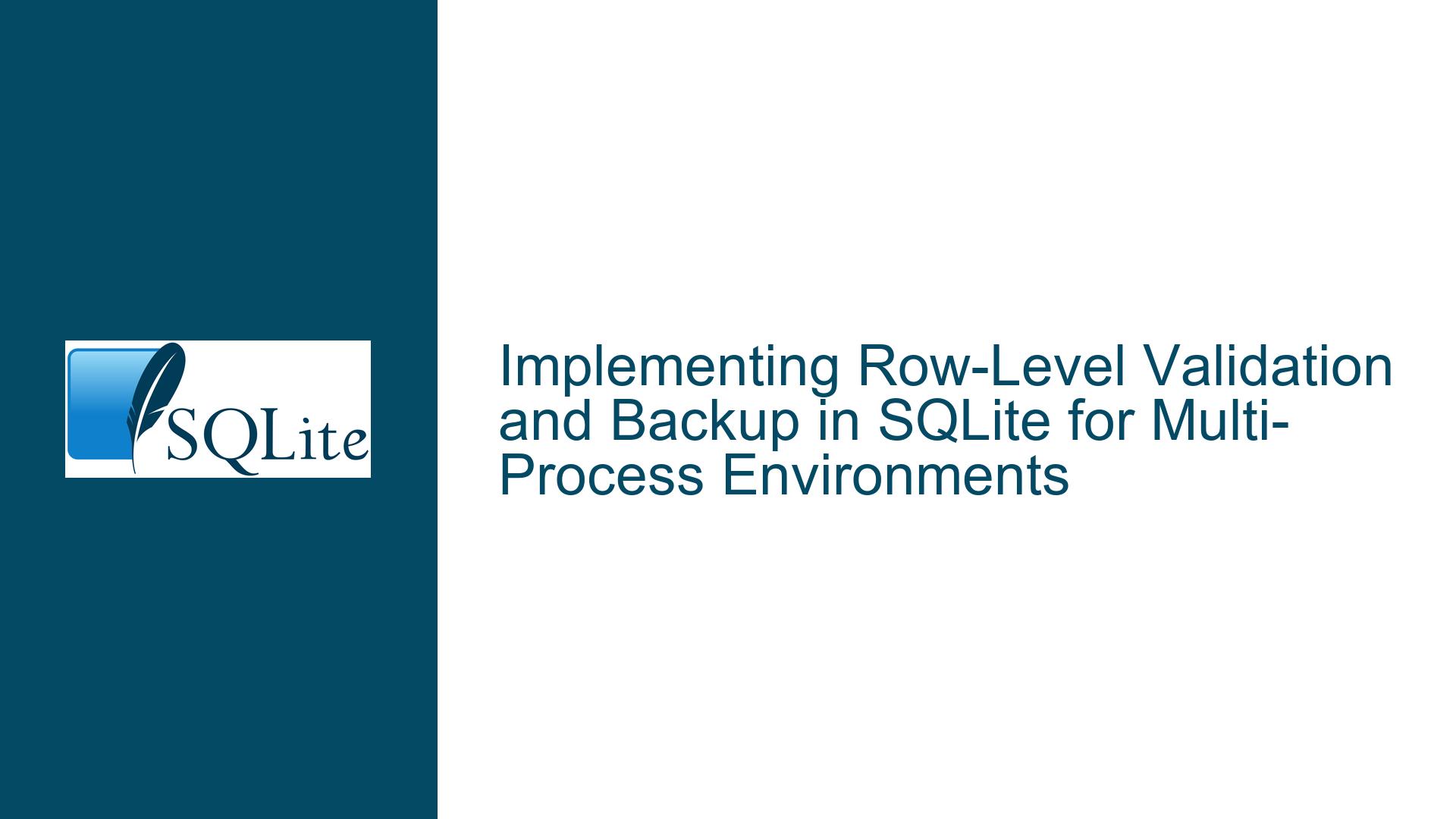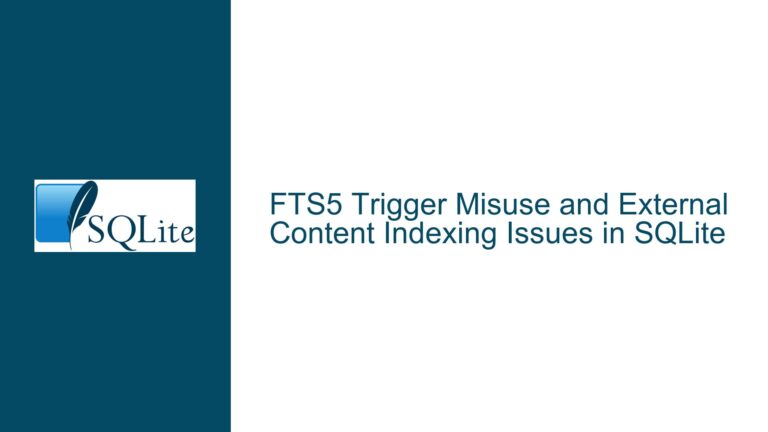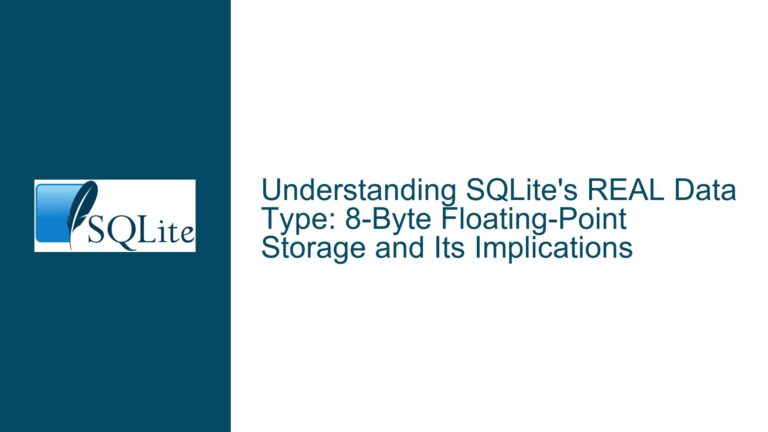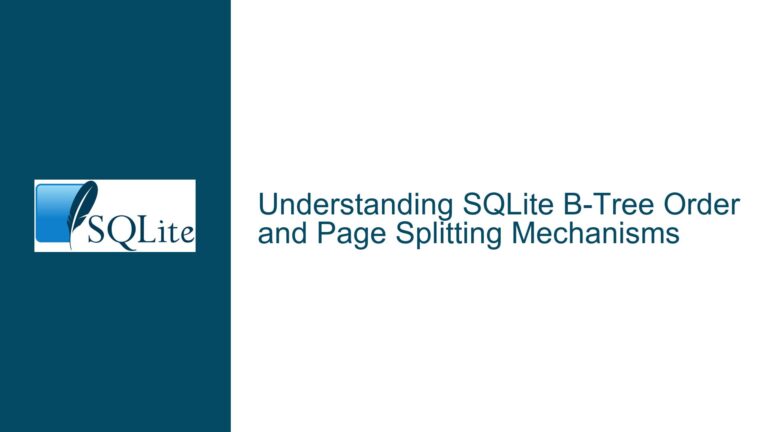Implementing Row-Level Validation and Backup in SQLite for Multi-Process Environments
Validation and Backup Requirements for Multi-Process SQLite Configuration Database
In environments where multiple processes interact with a shared SQLite database, ensuring data integrity and providing robust backup mechanisms are critical. This is especially true when the database stores configuration data, as incorrect values can lead to system-wide issues. The primary concerns in such scenarios are:
- Row-Level Validation: Ensuring that each row adheres to specific validation rules, such as type checks, range constraints, and custom logic (e.g., validating that a MAC address and IP address in the same row are compatible).
- Backup and Rollback Mechanisms: Providing a way to back up the database before software updates or in the event of crashes, and enabling rollback to a previous state if necessary.
- External Communication Interface: Allowing external tools or processes to interact with the database through a wrapper layer that enforces validation rules and provides a visual interface for updates.
These requirements are particularly important in embedded systems or devices running Linux, where multiple processes may concurrently access the database. Without proper validation, one process could inadvertently corrupt the data, leading to system instability or failure. Similarly, without reliable backup and rollback mechanisms, recovering from software updates or crashes becomes challenging.
Leveraging SQLite Schema Constraints and Triggers for Row-Level Validation
SQLite provides several built-in mechanisms to enforce data integrity at the schema level. These include column constraints, CHECK clauses, and triggers. For row-level validation, the most effective tools are CHECK constraints and BEFORE INSERT/BEFORE UPDATE triggers.
CHECK Constraints
A CHECK constraint allows you to specify a condition that must be true for each row in the table. For example, if you have a table storing device configurations with columns for Serial#, MAC address, and IP address, you can enforce validation rules directly in the schema:
CREATE TABLE device_config (
Serial# TEXT NOT NULL,
MAC_address TEXT NOT NULL,
IP_address TEXT NOT NULL,
CHECK (LENGTH(Serial#) = 10 AND Serial# GLOB '[0-9][0-9][0-9][0-9][0-9][0-9][0-9][0-9][0-9][0-9]'),
CHECK (MAC_address GLOB '[0-9A-Fa-f][0-9A-Fa-f]:[0-9A-Fa-f][0-9A-Fa-f]:[0-9A-Fa-f][0-9A-Fa-f]:[0-9A-Fa-f][0-9A-Fa-f]:[0-9A-Fa-f][0-9A-Fa-f]:[0-9A-Fa-f][0-9A-Fa-f]'),
CHECK (IP_address GLOB '[0-9]*.[0-9]*.[0-9]*.[0-9]*')
);
In this example, the CHECK constraints ensure that:
- The
Serial#is exactly 10 digits long. - The
MAC addressfollows the standard format (e.g.,00:1A:2B:3C:4D:5E). - The
IP addressfollows the IPv4 format.
BEFORE INSERT and BEFORE UPDATE Triggers
For more complex validation logic that involves cross-referencing other rows or tables, BEFORE INSERT and BEFORE UPDATE triggers are the preferred solution. Triggers allow you to execute custom logic before a row is inserted or updated, and they can raise an error if the validation fails. For example:
CREATE TRIGGER validate_device_config BEFORE INSERT ON device_config
BEGIN
SELECT
CASE
WHEN NEW.Serial# NOT GLOB '[0-9][0-9][0-9][0-9][0-9][0-9][0-9][0-9][0-9][0-9]' THEN
RAISE(ABORT, 'Invalid Serial#')
WHEN NEW.MAC_address NOT GLOB '[0-9A-Fa-f][0-9A-Fa-f]:[0-9A-Fa-f][0-9A-Fa-f]:[0-9A-Fa-f][0-9A-Fa-f]:[0-9A-Fa-f][0-9A-Fa-f]:[0-9A-Fa-f][0-9A-Fa-f]:[0-9A-Fa-f][0-9A-Fa-f]' THEN
RAISE(ABORT, 'Invalid MAC address')
WHEN NEW.IP_address NOT GLOB '[0-9]*.[0-9]*.[0-9]*.[0-9]*' THEN
RAISE(ABORT, 'Invalid IP address')
END;
END;
This trigger ensures that any attempt to insert or update a row in the device_config table will fail if the data does not meet the validation criteria.
Backup and Rollback Strategies for SQLite Databases
SQLite databases are stored as single files, making them easy to back up and restore. However, in a multi-process environment, care must be taken to ensure that backups are consistent and that rollback mechanisms are reliable.
Using the SQLite Backup API
SQLite provides a built-in backup API that allows you to create a consistent snapshot of the database while it is in use. This API is particularly useful for creating backups before software updates or in the event of a crash. The backup API ensures that the backup is atomic and consistent, even if other processes are writing to the database.
Here is an example of how to use the SQLite backup API in Python:
import sqlite3
def backup_db(source_db, backup_db):
source_conn = sqlite3.connect(source_db)
backup_conn = sqlite3.connect(backup_db)
with backup_conn:
source_conn.backup(backup_conn)
source_conn.close()
backup_conn.close()
# Example usage
backup_db('config.db', 'config_backup.db')
This script creates a backup of the config.db database and saves it as config_backup.db.
Rollback Mechanisms
Rollback mechanisms can be implemented using SQLite’s transaction management features. By wrapping operations in transactions, you can ensure that changes can be rolled back if an error occurs. For example:
BEGIN TRANSACTION;
-- Perform updates or inserts
INSERT INTO device_config (Serial#, MAC_address, IP_address) VALUES ('1234567890', '00:1A:2B:3C:4D:5E', '192.168.1.1');
-- If an error occurs, rollback
ROLLBACK;
-- If everything is fine, commit
COMMIT;
In this example, if the INSERT statement fails due to a validation error (e.g., an invalid Serial#), the transaction can be rolled back, leaving the database in its original state.
Building a Wrapper Layer for External Communication and Validation
To provide a visual interface and enforce validation rules for external processes, you can build a wrapper layer around the SQLite database. This wrapper can be implemented as a web application, a command-line tool, or a custom API.
Web Application Wrapper
A web application wrapper allows external tools to interact with the database through a user-friendly interface. The web application can enforce validation rules before passing data to the database and provide features like backup and rollback. For example, using Flask in Python:
from flask import Flask, request, jsonify
import sqlite3
app = Flask(__name__)
DATABASE = 'config.db'
def validate_device_config(serial, mac, ip):
# Add validation logic here
if not serial.isdigit() or len(serial) != 10:
return False
if not all(c in '0123456789ABCDEFabcdef:' for c in mac):
return False
if not all(part.isdigit() and 0 <= int(part) <= 255 for part in ip.split('.')):
return False
return True
@app.route('/update_config', methods=['POST'])
def update_config():
data = request.json
serial = data.get('Serial#')
mac = data.get('MAC_address')
ip = data.get('IP_address')
if not validate_device_config(serial, mac, ip):
return jsonify({'error': 'Invalid data'}), 400
conn = sqlite3.connect(DATABASE)
cursor = conn.cursor()
try:
cursor.execute('INSERT INTO device_config (Serial#, MAC_address, IP_address) VALUES (?, ?, ?)', (serial, mac, ip))
conn.commit()
except sqlite3.IntegrityError as e:
conn.rollback()
return jsonify({'error': str(e)}), 400
finally:
conn.close()
return jsonify({'message': 'Update successful'}), 200
if __name__ == '__main__':
app.run(debug=True)
This Flask application provides an API endpoint for updating the device_config table. It validates the input data before inserting it into the database and handles errors gracefully.
Command-Line Tool Wrapper
A command-line tool wrapper can be used to interact with the database from scripts or other processes. The tool can enforce validation rules and provide backup and rollback functionality. For example:
import argparse
import sqlite3
def validate_device_config(serial, mac, ip):
# Add validation logic here
if not serial.isdigit() or len(serial) != 10:
return False
if not all(c in '0123456789ABCDEFabcdef:' for c in mac):
return False
if not all(part.isdigit() and 0 <= int(part) <= 255 for part in ip.split('.')):
return False
return True
def update_config(serial, mac, ip):
if not validate_device_config(serial, mac, ip):
print('Invalid data')
return
conn = sqlite3.connect('config.db')
cursor = conn.cursor()
try:
cursor.execute('INSERT INTO device_config (Serial#, MAC_address, IP_address) VALUES (?, ?, ?)', (serial, mac, ip))
conn.commit()
print('Update successful')
except sqlite3.IntegrityError as e:
conn.rollback()
print(f'Error: {e}')
finally:
conn.close()
if __name__ == '__main__':
parser = argparse.ArgumentParser(description='Update device configuration')
parser.add_argument('--serial', required=True, help='Serial number')
parser.add_argument('--mac', required=True, help='MAC address')
parser.add_argument('--ip', required=True, help='IP address')
args = parser.parse_args()
update_config(args.serial, args.mac, args.ip)
This command-line tool validates the input data and updates the device_config table. It provides a simple interface for external processes to interact with the database.
Conclusion
Implementing row-level validation and backup mechanisms in a multi-process SQLite environment requires careful planning and the use of SQLite’s built-in features. By leveraging CHECK constraints, triggers, and the backup API, you can ensure data integrity and provide reliable backup and rollback options. Additionally, building a wrapper layer around the database allows external tools and processes to interact with the database while enforcing validation rules and providing a user-friendly interface. These strategies are essential for maintaining the stability and reliability of systems that rely on SQLite for configuration data.






